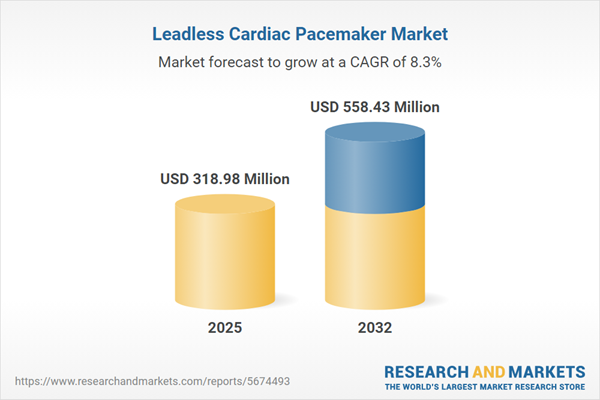Speak directly to the analyst to clarify any post sales queries you may have.
The Leadless Cardiac Pacemaker Market is transforming cardiac rhythm management by providing healthcare organizations with wireless, minimally invasive devices that support efficient, scalable, and patient-focused care models.
Market Snapshot: Leadless Cardiac Pacemaker Market
The global Leadless Cardiac Pacemaker Market is demonstrating rapid expansion, propelled by increased clinical adoption of advanced wireless technologies and a growing transition from traditional implantable pacemakers. Senior healthcare decision-makers are driving this progress by prioritizing device longevity and improved reliability, shifting organizational strategies to focus on scalable, outpatient, and ambulatory environments. Across various care settings—from cardiac specialty centers to outpatient facilities—providers recognize the value of integrated, minimally invasive devices in patient management. Significant investment signals ongoing industry commitment to delivering next-generation, patient-centered cardiac solutions. A dynamic competitive landscape emphasizes clinical innovation as essential for enhancing healthcare system agility, operational efficiency, and extended facility capability.
Scope & Segmentation
This executive-level report evaluates key factors shaping the Leadless Cardiac Pacemaker Market, emphasizing their impact on organizational strategy, procurement, and care outcomes. The segmentation landscape features:
- Product Type: Dual chamber and single chamber pacemakers address a wide spectrum of clinical requirements, enabling providers to match device functionality with specific patient populations and cardiac arrhythmia protocols.
- End User: Hospitals, ambulatory surgery centers, outpatient heart facilities, specialty cardiac clinics, and telecardiology providers each influence market expansion and facilitate broader device accessibility across diversified clinical environments.
- Pacing Mode: VVI and VVIR (Adaptive Rate Response) functionalities adapt device output to the individual’s physiologic and activity variations, ensuring responsive, tailored pacing while supporting complex treatment regimens.
- Distribution Channel: Direct sales, established distributor alliances, and digital procurement—including e-commerce options—offer streamlined purchasing and enable rapid, enterprise-level device rollout aligned with operational demands.
- Indication: Devices address indications such as atrial fibrillation, atrioventricular block, and symptomatic bradycardia, reflecting the sector’s flexibility in managing diverse cardiac rhythm disorders and supporting compliance with safety protocols.
- Geographic Coverage: Analysis spans the Americas, Europe, Middle East & Africa, and Asia-Pacific, with additional emphasis on China, India, Japan, Australia, and Southeast Asia. Regional dynamics explore how regulatory frameworks and healthcare infrastructure influence local adoption and market expansion.
- Company Coverage: Key market participants include Medtronic plc, Abbott Laboratories, Boston Scientific Corporation, Biotronik GmbH & Co. KG, MicroPort Scientific Corporation, Lepu Medical Technology Co., Ltd., and LivaNova PLC, reflecting leadership and innovation continuity within the competitive landscape.
Key Takeaways for Senior Decision Makers
- Integration of leadless cardiac pacemakers into procedural workflows elevates device management and coordination, supporting more robust care delivery across a variety of healthcare facilities.
- Expansion in outpatient and ambulatory environments enhances organizational responsiveness and promotes scalable, future-proof care delivery models addressing evolving operational needs.
- Innovations in microelectromechanical systems, advanced imaging, and wireless telemetry enable improved procedural precision, real-time data integration, and optimal outcomes within digital healthcare infrastructures.
- Stronger collaboration between device manufacturers, digital health technology partners, and regulators enables greater interoperability while simplifying compliance and reducing operational complexity.
- Implementation of post-implantation monitoring at points of care improves organizational agility, allowing rapid adaptation to updated protocols and shifting clinical requirements.
- Regionally tailored strategies, including customized reimbursement approaches and infrastructure investments, reinforce the sustainability of adoption and support alignment with demographic trends and local regulatory conditions.
Tariff Impact: Navigating Economic Headwinds in 2025
The anticipated introduction of tariffs on microelectronic components and specialized materials is expected to elevate operational costs for stakeholders in 2025. Manufacturers and healthcare organizations are proactively deploying mitigation strategies, such as near-shore sourcing models, seeking tariff exemptions, and carefully managing budget allocations to protect innovation priorities. Active regulatory engagement remains essential for maintaining device availability, preserving supply chain resilience, and ensuring consistent patient care during fluctuating economic conditions.
Methodology & Data Sources
This market analysis integrates direct perspectives from electrophysiologists, hospital administrators, and reimbursement advisors in major global markets. The study draws from regulatory filings, recent clinical trials, industry whitepapers, and advanced analytics, resulting in an objective and comprehensive market overview.
Why This Report Matters
- Provides actionable insights for executive teams seeking to align advanced leadless pacemaker technology adoption with broader organizational priorities and resource planning.
- Delivers precise segmentation and regional data to help healthcare systems tailor business strategies, operations, and procurement processes to local demands.
- Supports transparency, risk management, and strategic positioning as next-generation cardiac rhythm devices increasingly become standard of care.
Conclusion
Focused investment in technology and ongoing innovation are accelerating adoption of leadless pacemakers, empowering healthcare organizations to deliver effective patient care while optimizing efficiency in quickly evolving clinical environments.
Additional Product Information:
- Purchase of this report includes 1 year online access with quarterly updates.
- This report can be updated on request. Please contact our Customer Experience team using the Ask a Question widget on our website.
Table of Contents
3. Executive Summary
4. Market Overview
7. Cumulative Impact of Artificial Intelligence 2025
Companies Mentioned
The companies profiled in this Leadless Cardiac Pacemaker market report include:- Medtronic plc
- Abbott Laboratories
- Boston Scientific Corporation
- Biotronik GmbH & Co. KG
- MicroPort Scientific Corporation
- Lepu Medical Technology Co., Ltd.
- LivaNova PLC
Table Information
| Report Attribute | Details |
|---|---|
| No. of Pages | 186 |
| Published | October 2025 |
| Forecast Period | 2025 - 2032 |
| Estimated Market Value ( USD | $ 318.98 Million |
| Forecasted Market Value ( USD | $ 558.43 Million |
| Compound Annual Growth Rate | 8.3% |
| Regions Covered | Global |
| No. of Companies Mentioned | 8 |









